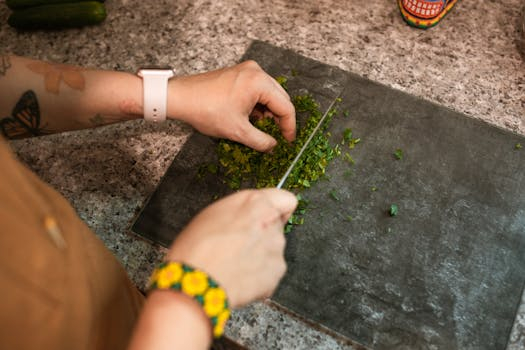Knife Skills 101: The Foundation of Every Great Cook
If you’re looking to improve your cooking skills and take your meals to the next level, then mastering knife skills is a must. Whether you’re a beginner or an experienced cook, proper knife skills are the foundation of every great chef’s repertoire. Not only do they help you prepare ingredients faster and more efficiently, but they also create consistency and elevate the overall taste and presentation of your dishes. In this article, we’ll dive into the basics of knife skills, why it’s crucial to learn them, and how to do it like a pro.
The Importance of Knife Skills
Knife skills are not just about chopping, slicing, and dicing. It involves understanding the different types of knives and how to use them correctly, holding the knife at the right angle, and having proper cutting techniques. Just like an artist needs to master their tool, a chef needs to master their knife. Here’s why mastering knife skills is so important:
Efficiency and Speed
In the fast-paced world of cooking, time is of the essence. Professional chefs are expected to work quickly and efficiently to keep up with the demands of a busy kitchen. By mastering knife skills, you’ll be able to chop, dice, and slice ingredients in a fraction of the time it would take an amateur cook. As the saying goes, practice makes perfect; with continuous practice, you’ll find yourself working through ingredients with ease and saving time in the process.
Consistency in Cooking
Consistency is key in cooking. Whether you’re cooking for yourself, your family, or a restaurant, you want your dishes to have the same taste and presentation every time. Having consistent knife skills ensures that the ingredients are cut to the same size and shape, resulting in even cooking and a uniform appearance. This is especially important when cooking dishes that require precision, like soups, stews, and stir-fries.
Enhances Flavor and Texture
Believe it or not, the way you cut ingredients can greatly impact the flavor and texture of your dishes. For example, slicing an onion with the grain will release more of its juices, resulting in a sweeter and milder taste. Chopping against the grain, on the other hand, releases more oils, giving the dish a stronger and more pungent flavor. Knowing how to cut different ingredients will also ensure that they are cooked evenly, resulting in the perfect texture.
Safety and Professionalism
Proper knife skills not only make you a better cook but also a safer one. When you know how to handle your knife correctly, you’ll reduce the risk of injuries and accidents in the kitchen. Additionally, having professional knife skills will make you more confident in the kitchen and give you an edge in the culinary industry if that’s your career goal.
The Basics of Knife Skills
Before we get into the various knife techniques, let’s start with the basics. Here are some essential tips to keep in mind when handling a knife:
Choose the Right Knife for the Job
There are different types of knives, each designed for a specific purpose. The three most commonly used are the chef’s knife, paring knife, and serrated knife. A chef’s knife, with its broad and curved blade, is perfect for slicing, dicing, and mincing vegetables and meats. The paring knife, with its small and thin blade, is ideal for peeling and trimming fruits and vegetables. The serrated knife, with its jagged edge, is best used for cutting through crusty bread and soft fruits and vegetables.
Hold the Knife Correctly
The correct way to hold a knife is by grasping the handle with your dominant hand and placing your thumb and index finger on the blade’s opposite sides. Your other fingers should be curled around the handle for support. This grip gives you the most control over the knife.
Keep Your Knives Sharp
A sharp knife not only works better but is also safer to use. Dull knives require more force to cut, increasing the risk of the knife slipping and injuring you. Invest in a good quality sharpener or have your knives professionally sharpened regularly.
Mastering Knife Techniques
Now that you have the basics covered let’s move on to some essential knife techniques that every cook should know:
Mincing
Mincing is a technique used to finely chop herbs, garlic, onion, or other ingredients into small pieces. Start by cutting the ingredient into thin slices, then holding it with your non-dominant hand, use your dominant hand to chop the slices into fine pieces. Keep your fingertips tucked in to avoid any accidents.
Julienning
Julienning involves cutting vegetables into long, thin strips. Start by cutting the vegetable into rectangular slices, then stack the slices on top of each other and cut them lengthwise into even strips. This technique is commonly used for stir-fries, salads, and garnishes.
Dicing
Dicing involves cutting ingredients into small cubes of equal size. Start by cutting the ingredient into rectangular slices, then stack and cut them into sticks of the desired size. Finally, turn the sticks and cut them into cubes. Dicing is commonly used for soups, stews, and sauces.
Other essential techniques to learn include chiffonade (stacking and slicing ingredients into thin ribbons), brunoise (cutting ingredients into tiny cubes), and batonnet (cutting vegetables into long, thin sticks). With practice, you’ll be able to master these techniques and elevate your cooking to the next level.
Conclusion
Knife skills are fundamental to every great cook. By mastering the basics and practicing different techniques, you’ll be able to cook faster, more efficiently, and with better results. Remember to always handle your knives with care, choose the right knife for the job, and keep them sharp. With continuous practice, you’ll find yourself cutting ingredients like a pro and taking your dishes to the next level.











